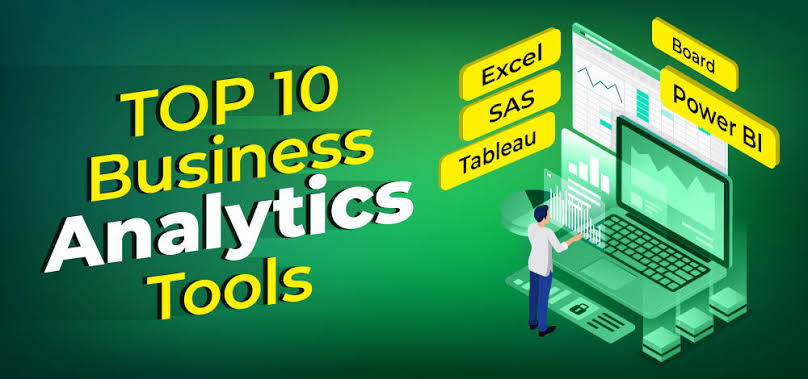In today's data-driven world, businesses rely heavily on data analytics tools to gain valuable insights, make informed decisions, and stay competitive. These tools empower organizations to analyze large volumes of data efficiently, uncover patterns and trends, and extract meaningful information. From traditional business intelligence platforms to advanced machine learning algorithms, there is a wide range of data analytics tools available to meet diverse business needs. Here, we explore the top 10 data analytics tools that are transforming the way businesses operate and strategize in the digital age.
1. Tableau
Tableau is a leading data visualization and business intelligence tool that enables users to create interactive and shareable dashboards. It simplifies complex data into visually appealing charts, graphs, and maps, making it easy for decision-makers to understand trends and patterns. Tableau supports data connectivity with various sources, including databases, cloud services, and spreadsheets, making it a versatile choice for data analysis across different industries.
2. Power BI
Microsoft Power BI is another powerful business intelligence tool that provides interactive data visualization capabilities. It integrates seamlessly with Microsoft products and services, allowing users to create insightful reports and dashboards. Power BI supports real-time data analysis and offers robust data modeling capabilities, making it suitable for both small businesses and large enterprises looking to leverage their data for strategic decision-making.
3. Google Analytics
Google Analytics is a widely used web analytics tool that helps businesses track and analyze website traffic and user behavior. It provides valuable insights into audience demographics, acquisition channels, and conversion rates, enabling businesses to optimize their online presence and marketing strategies. Google Analytics offers customizable reports and real-time data monitoring, making it essential for digital marketing and e-commerce businesses.
4. Apache Hadoop
Apache Hadoop is an open-source framework designed for distributed storage and processing of large datasets. It enables businesses to store and analyze vast amounts of structured and unstructured data across clusters of commodity hardware. Hadoop's ecosystem includes various tools like HDFS (Hadoop Distributed File System) for storage and MapReduce for processing, making it a scalable solution for big data analytics and batch processing tasks.
5. SAS
SAS (Statistical Analysis System) is a comprehensive analytics platform that offers advanced statistical analysis, data management, and predictive modeling capabilities. It is widely used in industries such as banking, healthcare, and retail for complex data analysis and forecasting. SAS supports data integration from multiple sources and provides a user-friendly interface for data exploration and visualization.
6. IBM Watson Analytics
IBM Watson Analytics is an AI-powered data analytics platform that enables businesses to uncover insights from structured and unstructured data. It leverages natural language processing (NLP) and machine learning algorithms to automate data preparation, predictive modeling, and visualization. IBM Watson Analytics is suitable for businesses looking to harness AI-driven insights for decision-making and strategic planning.
7. QlikView/Qlik Sense
QlikView and Qlik Sense are data visualization and analytics platforms that empower users to create interactive dashboards and reports. They offer associative data indexing, allowing users to explore data relationships and make data-driven discoveries. Qlik's in-memory data processing capabilities enable real-time data analysis and provide powerful visualization tools for business users and data analysts alike.
8. R Programming Language
R is an open-source programming language and environment for statistical computing and graphics. It offers a vast array of statistical and graphical techniques for data analysis, making it popular among data scientists and statisticians. R's extensive library of packages allows for advanced data manipulation, visualization, and predictive modeling, making it a versatile tool for data-driven decision-making in research and business.
9. Python
Python is a versatile programming language known for its simplicity and readability, making it increasingly popular for data analysis and machine learning tasks. Python's libraries such as NumPy, pandas, and scikit-learn provide robust tools for data manipulation, analysis, and modeling. It is widely used in industries ranging from finance to healthcare for building data pipelines, performing statistical analysis, and developing machine learning models.
10. Alteryx
Alteryx is a self-service data analytics platform that enables users to blend, prepare, and analyze data from various sources without coding. It offers drag-and-drop tools for data integration, cleansing, and predictive analytics, streamlining the data preparation process. Alteryx's workflow automation capabilities and predictive modeling tools make it ideal for data analysts and business users looking to derive actionable insights from complex datasets.
Conclusion
Choosing the right data analytics tools is crucial for businesses aiming to harness the power of data for strategic decision-making and operational efficiency. Whether it's visualizing data with tools like Tableau and Power BI, analyzing big data with Apache Hadoop, or leveraging AI-driven insights with IBM Watson Analytics, each tool offers unique features and capabilities to meet specific business needs. By investing in the right data analytics tools and empowering teams with data-driven insights, businesses can gain a competitive edge, drive innovation, and achieve sustainable growth in today's dynamic market landscape. Understanding the strengths and applications of these top 10 data analytics tools is essential for businesses navigating the complexities of data analysis and leveraging data as a strategic asset.
